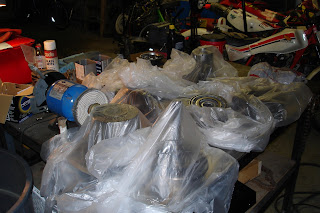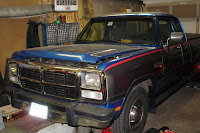I had some advice from someone that basically went, "Go and buy and case of spray solvent, like brake cleaner. You'll use it." Well I didn't buy a case. But I bought six cans. I happened to use Brakleen brand. It turned out to be the cheapest. It's what I use all the time anyway, and it does a good job. It's a highly volitol solvent that washed away all the grime and doesn't leave a film or any residue.

They also make a non-chlorinated version that comes in a green can. I don't know if it's actually "greener" in the eco sense, but I assume so. I would have got that, but the store was all out.
I went through 5 cans doing the cleanup of all the parts. I didn't bother cleaning the clutches since those are going in the trash bin anyway. I have 1 can left that will just about do it for cleaning up both cases. So maybe a full case is a bit more than you'll need.
My method was this. My wife was getting rid of an old 8 quart roaster. I sprayed the parts over this pan and let the excess run down into it. When that got about 1/2" of fluid in the bottom I started just rinsing the parts in that. If the part needed a little extra I'd spray some more from the can. I then dried the parts with compressed air using a normal air nozzle. It worked really slick.
After cleaning and drying the parts I put the major subassemblies on the cookie sheets and put them in a plastic garbage bag. It's so dry here in Colorado I don't really worry about the parts rusting in this situation. If I were somewhere else where there's more humidity I'd probably dunk the parts in some fresh transmission fluid before wrapping them up.
I spent the better part of a Sunday doing this. It is a littel time-consuming. But cleanliness is the key. Remember: no lint in the transmission!
Here's the major subassemblies, all wrapped up, just waiting for the UPS truck to come with new parts.

That's about it for the cleanup. Next: the "brown truck" comes with the new parts.













